We known the current world situation where no place to lives natural Animals, Birds, Insects.
Insects one the most importance part of our Ecosystem, therefore our responsibility to take care about our nature and natural resources. Following are some top 15 rear insects found all around world. Lets take information about its.
1) Land lobster ( Most rear insect in the world )
 |
| Image source - google | Image by - wikipedia |
Scientific name - Dryococelus australis
Found in - It is found in the waters between Eastern Canada and North Carolina, Most lobster caught in the United state. It is most rear insects species in the World.
Lives in - Lobster lives in to the water, but sometimes out of the water for couple of days if kept in moist and cool place.
Description - Lobsters are spineless creatures with a hard defensive exoskeleton. Like most arthropods, lobsters must shed to develop, which leaves them defenseless. During the shedding procedure, a few animal categories change shading. Lobsters have eight strolling legs; the front three sets bear hooks, the first are bigger than the others.
Lobster life structures incorporates two principle body parts the cephalothorax and the mid-region. The cephalothorax wires the head and the chest, the two of which are secured by a chitinous carapace. The lobster's head bears recieving wires, antennules, mandibles, the first and second maxillae. The head additionally bears the compound eyes. Since lobsters live in dim conditions at the base of the sea, they for the most part utilize their recieving wires as sensors.
Food - It usually eat fish, crabs, clams, mussels, sea urchins, and sometimes even other lobsters
lifespan - 34 year for male and 54 year for female.
2) Hercules beetle ( Largest beetle in the world )
 |
Hercules beetle |
Scientific name - Dynastes hercules
Found in - It is found in rainforest of Central America, South America and Lesser Antilles. It is a Largest beetle in the world.
Lives in - It is lives in rainforest, hidden in rotten tree trunks.
Description - Adult body sizes change somewhere in the range of 50 and 85 mm long and 29 and 42 mm in width. Male Hercules creepy crawlies may reach up to 173 mm long (counting the horn), making them the longest types of bug on the planet, if jaws as well as horns are remembered for the estimation.
The size of the horn is normally factor, more so than any variety of the size of legs, wings, or by and large body size in the species. he assemblage of guys is dark except for the elytra, which can have shades of olive-green Females of hercules have punctured elytra which are normally completely dark, yet some of the time have the last quarter of the elytra hued similarly as the guys.
Food - Adult male and female eat rotten apples, orange slices, overripe bananas, and similar fruit.
lifespan - 3 - 6 months
3) Assassin bug
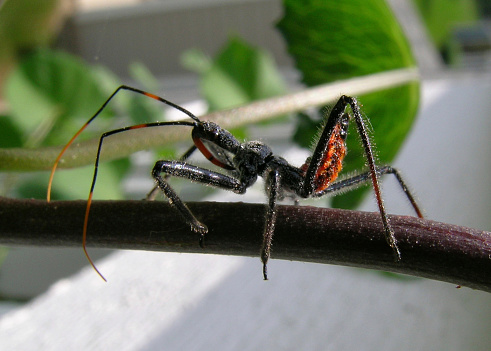 |
Assassin bug |
Scientific name - Reduviidae
Found in - It is found in United States, and in Arizona, California, Texas, and New Mexico.
Lives in - It is lives in tropical region land.
Description - They go in size from 5 to 40 mm . A professional killer bug utilizes its short three-sectioned bill to puncture its prey and afterward suck the body liquids from its casualties. A quality of the family is that the bill is bended and lies in a notch between the front legs. Despite the fact that professional killer bugs are commonly dark or dim earthy colored, a few animal varieties are splendidly shaded. Most individuals from the family live outside and go after different creepy crawlies. Nonetheless, some suck blood from vertebrates, including people, and transmit ailments.
Food - Some species of assassin bugs are predators, some species feed on insects while others feed on the blood of mammals.
lifespan - Between 1 and 2 year.
4) Giant long legged katydid
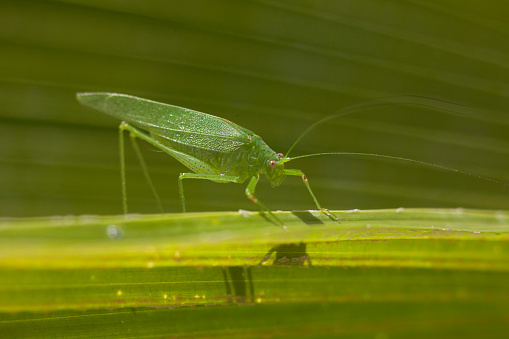 |
Giant long legged katydid |
Scientific name - Macrolyristes corporalis
Found in - This species of insects found in Malaysia.
Lives in - They live in tropical forest in Malaysia. In day time, they remain motionless and use their camouflage to avoid predators. At night, they use their long antennae to find food and see for a mate.
Description - This is the biggest types of katydid in the world. These mind boggling bugs originate from the forested mountain slants of tropical Malaysia. During the day, they stay not moving and utilize their cover to dodge predators. Around evening time, they utilize their long radio wires to discover food and search for a mate. The guys produce a very boisterous, sharp commotion to require a female.
Katydids are identified with grasshoppers, so they seem to be comparable, yet notice the long reception apparatuses and leaf-like appearance of the wings. These qualities recognize them from their grasshopper family members, which have short receiving wires and wings collapsed level over the back. Most katydids eat leaves, however some are predators that eat other little creepy crawlies.
Food - Most katydids insect eat leaves, but some are predators that eat other small insects.
lifespan - After moving out from egg they might survive 3-4 months, but some of them live year also.
5) Goliath beetle
 |
Goliath beetle |
Scientific name - Goliathus
Found in - All species of Goliath beetle found in Africa.
Lives in - It is live in Tropical forest, in which they have plenty of food.
Description - Oliath beetles, as practically all different scarabs, have a fortified first pair of wings that go about as defensive spreads for their auxiliary pair of wings and midsection. Just the second pair of wings are really utilized for flying. At the point when not being used, they are kept totally collapsed underneath the elytra. Every one of the insect's legs closes in a couple of sharp hooks, which give a solid hold valuable to jumping on tree trunks and branches. Guys have a Y-formed horn on the head, which is utilized as a pry bar in fights with different guys over taking care of locales or mates. Females are without a horn and rather have a wedge-formed head that helps with tunneling when they lay eggs. Notwithstanding their enormous size, Goliath insects are strikingly designed also. Noticeable markings normal to the entirety of the Goliathus species are the strongly differentiating dark vertical stripes on the pronotum.
Food - It is eat different types of plant material, fruit, dung and remaining of dead animals.
lifespan - About 3 months.
6) Giant burrowing cockroach
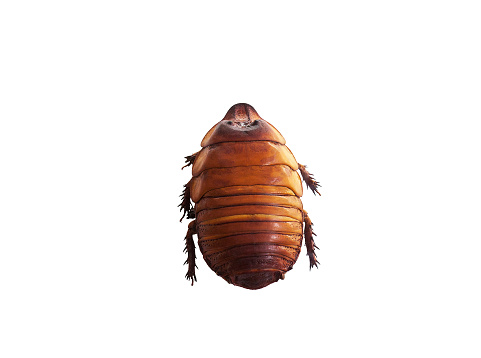 |
Giant burrowing cockroach |
Scientific name - Macropanesthia rhinoceros
Found in - Most of it's species are mostly found in Queensland, Australia.
Lives in - It is live in coastal stretch between Rockhampton and Cooktown.
Description - The Giant Burrowing Cockroach is recognizable by their huge size and weight. The size of a grown-up monster tunneling cockroach can reach over 60mm and up to 75-80mm, and can weigh as much as 30-35 grams. The pronotum is a noticeable plate-like structure that covers all or part of the chest of creepy crawlies, and for the Giant Burrowing Cockroach, it can surpass 15mm. Their pronotum helps with burrowing, going about as a scoop. Its midsection lays on the ground. The cockroach additionally has tubercles, which are little or adjusted projections particularly on a bone or surface.
Grown-up guys and females can be separated by the size of the "scoop" on the pronotum, which covers the head; with the male having a considerably more articulated scoop.
The youthful of the monster tunneling cockroaches are alluded to as sprites. The sprites are brought into the world a smooth white shading when conceived, yet before long build up a rosy earthy colored shading. Both grown-up female and male cockroaches are dull earthy colored.
Food - It is omnivorous scavengers and will consume any organic food source available to them. Mostly they eat sweets, meats and starches, they also eat other items such as hair, books and decaying matter.
lifespan - Female estimated lifespan is 180 days, Male adult lifespan is 160 days.
7) Thorn bug
Scientific name - Umbonia crassicornis
Found in - It is found on every continent except Antarctica, but mostly live in forests in South and Central America and in Asia.
Lives in - Mostly lives in forest . They are vary in size and color, but they all have tall thorn-shaped horns on there backs.
Description - Umbonia crassicornis is a typical and far reaching individual from the bug family Membracidae, and one of the various animal groups normally alluded to as thistle bugs. The body length of the grown-up is roughly 10 millimeters . This is a variable animal categories as to measure, shading and structure, especially the pronotal horn of guys . This tall, basically opposite thistle like pronotum disheartens fowls and different predators from eating it, if just by erroneously befuddling it with a thistle. Commonly, the grown-up is green or yellow with ruddy lines and earthy markings.
Food - It is eat the plants that they live on. By using their beak-shaped mouths, they pierce plant stems and feed on the sap inside.
lifespan - Not exactly but they live 1-2 year.
8) Titan beetle
Titan beetle

Titan beetle
Scientific name - Titanus giganteus
Found in - It typically found in the rain forests of Colombia, Ecuador, Peru, Bolivia, the Guianas and north-central Brazil
Lives in - lives in rain forest.
Description - The titan insect is probably the biggest creepy crawly, with the biggest dependable estimated example being 16.7 cm long, equivalent to such scarabs as Xixuthrus saints (15 cm ) and the Hercules bug, Dynastes hercules, in which monster guys every so often can grow up to 17.5 cm , yet the Hercules bug guys have a colossal horn on the pronotum or chest making up around half of its all out length. Accordingly, the body of the Titan insect is significantly bigger than that of the Hercules scarabs. The short, bended and sharp mandibles are known to snap pencils down the middle and cut into human flesh.Adult titan bugs don't take care of, reference required looking rather for mates through pheromones while in flight.
Food - They eat decaying wood below the ground, then spend just a few weeks as adults.
lifespan - Between 14 days to 6 months.
9) Indian Moon Moth
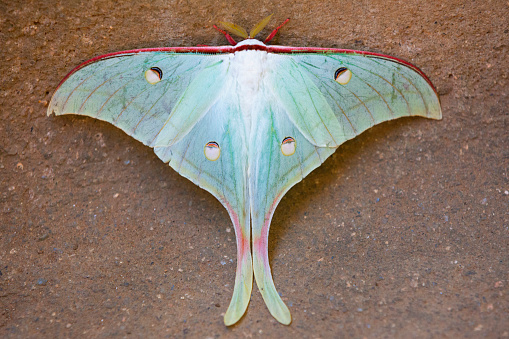 |
Indian Moon Moth |
Scientific name - Actias luna
Found in - It is mostly found in India.
Lives in - They lives in forest of central region of India.
Description - Male: Head, chest, and midsection white palpi pink, prothorax with a dim pink band; legs pink. Forewing exceptionally light green, white at base; a dim pink costal belt, darkest along subcostal vein: an apparently diagonal light yellow antemedial line two internally angled somewhat bended submarginal lines a light yellow minimal band a dim red-earthy colored lunule at end of cell, with a dim line on it, bouncing deep down a round ochreous spot with pinkish focus. Hindwing like the forewing the focal part of the tail pinkish.
Female: The external edge less extracted and waved; the yellow markings less created; the ante-medial line of fore wing closer the base, and that on hindwing missing; the tail less pink.
Food - Adult butterflies and moths eat only various liquids to maintain their water balance and energy stores. Most adults sip flower nectar, but other imbibe fluids from sap flowers on trees, rotting fruits, bird droppings, or animal dung.
lifespan - 28 days
10) Australian walking stick
 |
Australian walking stick |
Scientific name - Extatosoma tiaratum
Found in - Australia's tropical forested regions.
Lives in - Lives in trees and soil.
Description - Female adult tiaratum are secured with thistle like spikes for resistance and disguise. Their since quite a while ago, adjusted bodies develop to around 5 to 8 inches long.The females are additionally portrayed as "substantial bodied, brachypterous and various spines and integumental extensions on the face and legs, remembering a tuft of spines for the cone shaped occiput of the hypognathous head". As referenced, the wings of the female are excessively little for flying, particularly when she is gravid.
Showing the sexual dimorphism of numerous comparative bugs (especially different phasmids just as mantises), guys are little and more slender, developing just around 11 cm long and have three ocelli. Guys do not have the prickly developments aside from spikes around their appearances. They have long wings and are acceptable flyers who promptly get off the ground whenever upset or looking for females.
Food - It is eat blackberry, ficus, pyracantha, oak and rose leaves.
lifespan - Maximum 15 year
11) Brazilian treehopper ( weirdest looking insects )
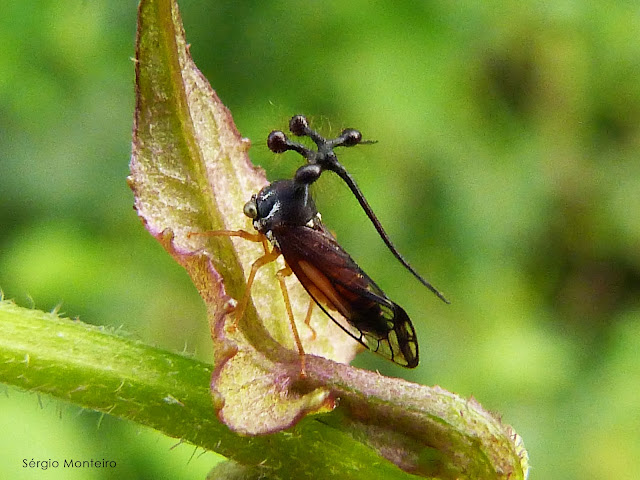 |
| Image source - google | Image by - wikipedia |
Scientific name - Bocydium globulare
Found in - It found in throughout the world, they are most prevalent in Africa, North and South America, Asia and Australia.
Lives in - They lives on tree
Description - The Brazilian 'treehopper' is among the most odd looking creepy crawlies I've at any point seen. It would appear that a helicopter creepy crawly from an outsider planet.
The main thing you may see about the treehopper is the odd recieving wire like round extremities on its head. They look like eyes, however they are essentially fancy and without a genuine capacity. In spite of the fact that it's conceivable that the globe-like extremities are there to deflect predators.
Other than the freaky headtopper, the treehopper is a genuinely typical bug. This bug flourishes with having a singular existence in treetops, benefiting from the undersides of leaves.
Food - The larva's main source of food comes from the inside of leaves. To be more specific, Brazilian tree hopper larvae feeds on the sap of leaves making it a sap-sucking insect.
lifespan - They live few months, but they belong to a lineage that is at least 40 million years old.
12) Atlas moth ( biggest lepidopteran )
 |
Atlas moth |
Scientific name - Attacus atlas
Found in - Forest of all around Asia.
Lives in - Trees
Description - The Atlas moth is probably the biggest lepidopteran, with a wingspan matching 24 cm and a wing surface territory of around 160 cm. It is just outperformed in wingspan by the white witch (Thysania agrippina) and Attacus caesar, and in wing surface zone by the Hercules moth (Coscinocera hercules). As in most Lepidoptera, females are perceptibly bigger and heavier than guys, while guys have more extensive radio wires.
The body is lopsidedly little contrasted with the wings. The upperside of the wings are rosy earthy colored with an example of dark, white, pink, and purple lines and triangular, scale-less windows flanked in dark.
Food - They do not eat food once they have emerged from the cocoon, relying on fat storage for energy.
lifespan - 5 -7 days.
13) Giant weta
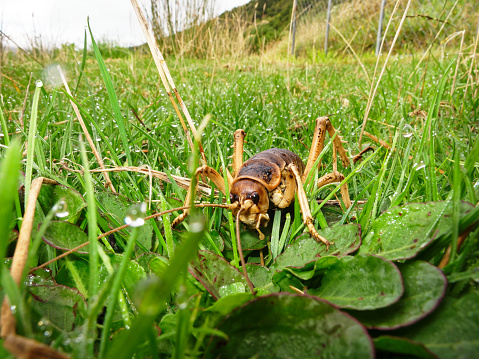 |
Giant weta |
Scientific name - Deinacrida
Found in - Found in New Zealand offshore islands,
Lives in - They lives in alpine, forests, grasslands, caves, shrub lands and urban gardens.
Description - There are eleven types of Giant weta, the majority of which are bigger than other wētā, notwithstanding the last additionally being enormous by creepy crawly norms. Enormous species can be up to 10 cm , not comprehensive of legs and reception apparatuses, with weight for the most part close to 35 g . One gravid hostage female arrived at a mass of around 70 g , making it probably the heaviest creepy crawly on the planet and heavier than a sparrow. This is, in any case, irregular, as this individual was unmated and held an anomalous number of eggs. The biggest types of goliath wētā is the Little Barrier Island mammoth wētā, otherwise called the wētāpunga. One model detailed in 2011 weighed 71 g .
Food - They mostly eat lichens, leaves, flowers, seed-heads, and fruit.
lifespan - 12 years
14) Calleta silkmoth caterpillar
 |
Calleta silkmoth caterpillar |
Scientific name - Eupackardia calleta
Found in - United state, New Mexico, Texas.
Lives in - Tree trunk.
Description - The Adult Calleta silkmoth has a dark body with a red neckline and red on the rear of the thorax.The wings, which ordinarily length 8-11 centimeters, are dark with prominent white post-middle lines which happen to be more extensive in females.They can likewise have enormous triangular white spots on their wings be that as it may, some may not.
Caterpillars or hatchlings are regularly splendid green in shading with white stripes just as have dark scoli sets with blue and orange bases, however these hues may fluctuate.
Food - They feed on ceniza ash Mexican jumping bean and ocotillo , while adults do not feed at all.
lifespan - 5 - 10 Days
15) Scorpion fly
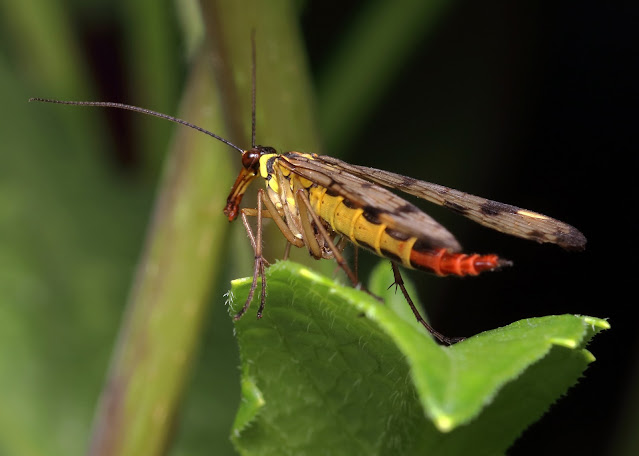 |
Scorpion fly |
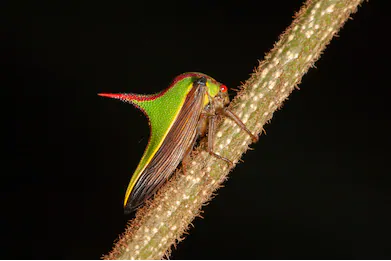




0 Comments
Comment for more blogs on nature.
EmojiDon't use improper words to comments.